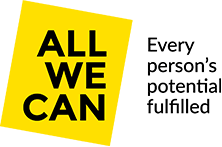International Day for Disaster Risk Reduction: Reflections from Malawi
Disaster Risk Reduction – the ways in which we can work with local communities to identify and reduce vulnerability, and find solutions that prevent or mitigate the negative impact of both natural and man-made hazards on human life and assets – is a fundamental component of Sustainable Development.
A ‘natural disaster’ is not a natural event. It is a combination of a natural hazard and human vulnerability and coping capacity, closely linked to physical assets and access to the services critical to the infrastructure of a society. As such, disasters nearly always hit the poorest communities the hardest.
In 2019 Cyclone Idai, one of the largest cyclones to impact Eastern Africa, caused mass devastation in Malawi, Mozambique and Zimbabwe. Thanks to the generous giving of All We Can’s supporters, subsequent to work responding to immediate emergency needs, All We Can sought to contribute to longer-term recovery, exploring the feasibility of a ‘Build Back Better’ initiative. The aim of this initiative is to assist the most vulnerable members of the communities impacted by the floods to rebuild stronger, safer and more flood-resilient houses.
These properties are designed to withstand the impact of high winds and heavy rain, are raised from the ground, and include drainage channels to reduce the risk of flooding. Should floodwaters rise higher than the raised floorplan, the properties are designed so that they are able to dry more quickly with improved ventilation. Furthermore, artisan members of the local community have the opportunity to increase their experience of using building methods and materials that contribute to increased resilience by participating in the construction process.
DRR is intrinsic to Sustainable Development. Sustainable Development reduces disaster risk. As such there are 25 targets related to DRR associated with 10 of the 17 Sustainable Development Goals. For example, Goal 2 includes achieving food security. In Malawi, one of All We Can’s local development partners has introduced a solar powered borehole as a means of securing a water source on a year round basis. This allows for multiple growing seasons. As well as flooding, this region of Malawi is also prone to drought, and so through introducing a reliable source of water this reduces the risk of water shortages associated with this hazard. The production of food can serve not only the immediate household of the small-holder farmer, but also as a source of income to enable access to other services such as education for their children.
DRR isn’t only concerned with structural engineering to withstand natural or man-made hazards and the positioning of physical assets away from said hazards – it is also associated with economic development and diversification of livelihoods, inclusive and equitable education and access to healthcare, land-use management, and maintaining and restoring ecosystems. It is about working with communities, not for communities.
DRR has a culture of learning at the centre. Otherwise, disasters will simply be repeated and the risk retained, if not made worse.
Disasters can, and should, be prevented. They should not be repeated.

